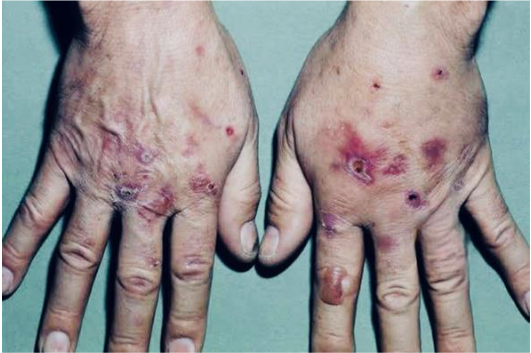A Presentation of Cutaneous Photosensitivity Diagnosed as A Case of Porphyria Cutanea Tarda in Hepatitis C
Main Article Content
Abstract
BACKGROUND: Porphyria is a rare enzyme metabolic disorder in heme biosynthetic pathway, resulting in accumulation of porphyrins or porphyrin precursor. Porphyria cutanea tarda (PCT) is the most common type of porphyria. PCT is due to deficiency of enzyme uroporphyrinogen decarboxylase (UROD). It can either be sporadic (type1) or familial (type2) and presents typically with cutaneous manifestations.
CASE: A 36-year-old male came with complaints of rash at the back of hand which heals with scar for the past 3 months, it increases on sun exposure. He is a known smoker and alcoholic. Lab findings revealed hepatitis C infection, elevated porphyrins. Patient was started on phlebotomy, low dose chloroquine and treatment for hepatitis C.
CONCLUSION: Extensive lesions on hands in the background of hepatitis C and alcohol history is characteristic of PCT. Treatment of HCV with antivirals reduces the viral load and symptoms of PCT. Phlebotomy to be done. Other preventive measure like reducing sun exposure, minimalize alcohol intake and avoiding possible trigger should be tried.
Article Details
References
Horner ME, Alikhan A, Tintle S, Tortorelli S, Davis DM, Hand JL: Cutaneous porphyrias part I: epidemiology, pathogenesis, presentation, diagnosis, and histopathology. Int J Dermatol 2013;52:1464-1480. External Resources Pubmed/Medline (NLM) , Crossref (DOI)
Köstler E, Wollina U. Therapy of porphyria cutanea tarda. Expert Opin Pharacother. 2005;6(3):377–83. [PubMed] [Google Scholar]
Lydia Sastre, Jordi To-Figueras, Sabela Lens, et al. Resolution of Subclinical Porphyria Cutaneatarda after Hepatitis C Eradication with Direct-Acting Anti-Virals. Aliment Pharmacol Ther. 2020; 51(10): 968- 973. doi: 10.1111/apt.15703
Anderson HB, Storandt MH, Kallamadi R, Bande D, Matta A. Iatro- genic Iron Overload Causing Porphyria Cutanea Tarda in a Patient With a Rare Nonsense Heterozygous UROD Gene Mutation. 2021; 13(7): e16215. doi: 10.7759/cureus.16215
Janssens L, Ji H, Greenlund A. Clin Gastroenterol Hepatol . 2021; 19(9): A19. doi: 10.1016/j.cgh.2020.05.028
Caballes FR, Sendi H, Bonkovsky HL. Hepatitis C, porphyria cutanea tarda and liver iron: an update. Liver Int. 2012;32(6):880–93. [PMC free article] [PubMed] [Google Scholar]
Elder GH. Porphyria Cutanea Tarda and related disorders. In: Kadish K, Smith K, editors. The Porphyria Handbook. Vol. 14. Elsevier Science; San Diego: 2003. p. 67. [Google Scholar]
Horner ME, Alikhan A, Tintle S, Tortorelli S, Davis DM, Hand JL: Cutaneous porphyrias part I: epidemiology, pathogenesis, presentation, diagnosis, and histopathology. Int J Dermatol 2013;52:1464-1480. External Resources Pubmed/Medline (NLM) , Crossref (DOI)

